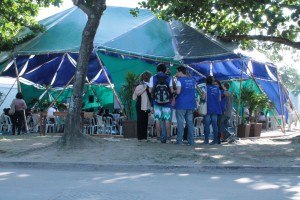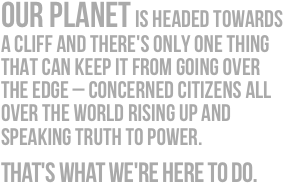A few important proposals, and what happened to them
By Jivan Sobrinho-Wheeler
Most of us from the [earth] team spent yesterday recovering from a six hour-long action at the RioCentro that included a People’s Plenary and walkout. There is a lot to be said about that process of protest, catharsis, and democracy in its rawest form, but I’ll leave it to someone else. For some reason I’m still itching to talk policy.
We ripped up the final document yesterday. With any kind of long-term vision, it’s obvious the outcome falls far short of the change we need. But initially even delegates and their governments were expecting Rio+20 to be a failure. So it came as a surprise to everyone when negotiators were able to make some tough compromises and come out with a trickle of progress. People put a lot of praise on the Brazilian presidency and their chairing of the negotiations. Here’s a breakdown of what was on the table and how it turned out, the successes and the complete failures:
Sustainable Consumption and Production. At the 19th Commission on Sustainable Development last year in New York, the world’s delegations finished negotiating a 10-Year Framework on SCP, but because the conference was unable to come to agreement on the other issues, which included waste, chemicals, and others, the Framework couldn’t be officially adopted. At Rio the U.S. played the elephant in the room for a while and refused to accept any outright inclusion of SCP in the text, but they eventually caved. The Framework was accepted. The American way of life is officially up for debate.
Rights. As someone on the inside told us, some of the text turned out to be Rio-1, Rio+1 or Rio+2, but some of it is, in fact, Rio+20. His example was the recognition of rights to food and water, as well as those of indigenous people, all in one document. Some of the hottest anger during the conference boiled when these rights were in danger, and some of it is still simmering at the absence of any reference to reproductive rights in the section on women.
UNEP. There was a recognition coming in that in order to give all three pillars of sustainable development (social, economic, environmental) an equal say in the international system, the status and power of the United Nations Environmental Program would have to be elevated. Many expected it would be made a specialized agency, which would mean putting it on the same level as the WTO and ILO, and that a name change to United Nations Environmental Organization was in order. The final document doesn’t go that far, but UNEP will get universal membership in its governing body, greater financing, and a strengthened hand in coordination within the UN system.
High Commissioner for Future Generations. Originally in the text was a proposition for a High Commissioner or Ombudsperson within the UN system who would be responsible for assessing the long-term impacts of current policies and advocating on behalf of future generations. There’s no reference to such a person in the final document, but the Secretary General is invited to make a report on “the need for promoting intergenerational solidarity for the achievement of sustainable development, taking into account the needs of future generations.”
The Future of the CSD. One of the major outcomes of the original Rio summit in 1992 was the creation of the Commission on Sustainable Development, which has met every year since. The Rio+20 document brings that era to a close. It will be replaced by an as yet unnamed high level political forum which will have the same mission as the CSD but be more action-oriented, have a larger role in bringing UN and other international multi-stakeholder groups to the table and ensuring coordination and cooperation between them, and produce a sustainable development report.
Fossil fuel subsidies. There was hope Rio+20 would herald a call to all nations to eliminate fossil fuel subsidies and start using that money to promote renewable energy. No such luck. The language on the reduction of fossil fuel subsidies is really weak.
Means of Implementation. The G-77 got pissed about the pace of MOI negotiations. At one point the bloc refused to show up to Green Economy talks because there was no progress on MOI. They said did not see the point of discussing the what when there was no attention give to the how. The end result still isn’t very good, and it may actually backtrack from the original Rio summit on the issue of technology transfer to developing countries.
Rio Principles. It was downright sad to see developed countries removing left and right references to the Rio Principles, which come from the 1992 summit and lay out in clear, concise language the principles on which sustainable development should be based. The most contentious debate was on common but differentiated responsibility (CBRD). The United States never liked the principle and now sees it as a way for emerging countries like China to point their finger at the developed world while shirking the burden their own economies are placing on the environment. Developing nations, however, are adamant that the countries putting the most pressure on the global environment should bear the biggest responsibility for changing their behavior and contributing to efforts to fix the problem.
Green Economy. The green economy has meant a lot of different things to a lot of different people. Some felt Europe was pushing a type of green neo-colonialism on the developing world in order to stimulate the economies of its member states. However, because of its inability to hold a strong common position or put money on the table, the EU failed to radically change the way the world economy will be structured. The end result encourages all countries to find their own ways to a green economy through a few a basic principles like poverty eradication, and encourages international partnerships and funding.
SDGs. Many have hoped for bold sustainable development goals that will replace the MDGs when they finish in 2015. These would apply to both developed and developing countries, focusing on sustainability and not just development. The outcome document, while failing to identify thematic areas for the goals, sets up a process for their creation.
Was Rio+20 a success or a failure? Civil society judged it the latter two days ago. As far as the historians go, a lot will depend of their narratives of the conference will depend what happens next. Now that the summit is over, how hard will governments push for new visions of development? What changes get implemented, which get swept aside, and what new ones are dreamed up? And how long will it be before humankind’s impacts on the planet become too obvious to ignore and the inequality within it becomes too much to bear?
Here’s to world that doesn’t need a Rio+40. Cheers.



